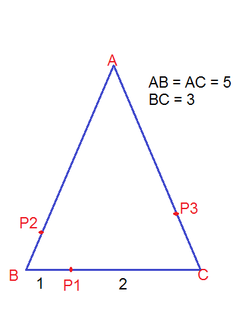Rational height of a Triangle inside a Triangle
 Diagram above is not to scale:
Diagram above is not to scale:
Let ABC be a given triangle with AB = AC = 5 and BC = 3, a point P1 is on BC such that BP1 = 1.
Points P2 and P3 are chosen on sides AB, AC respectively such that they are at the shortest distance from P1.
Find the height of the triangle P1P2P3, with respect to the base P2, P3.
While I was not interested in a irrational solution, the best i could do was to express the height as follows
h = ( c d ) ∗ d ∗ e a ∗ b
where a, b, c, d, e are distinct prime integers,
find a + b + c + d + e ?
Source: Own work.
The answer is 50.
This section requires Javascript.
You are seeing this because something didn't load right. We suggest you, (a) try
refreshing the page, (b) enabling javascript if it is disabled on your browser and,
finally, (c)
loading the
non-javascript version of this page
. We're sorry about the hassle.
2 solutions
height is
h = 5 2 × 2 × 2 3 1 3 × 7
a + b + c + d + e = 1 3 + 7 + 5 + 2 + 2 3 = 5 0
nice problem. I had a lengthy solution.
Log in to reply
I found the cosines of all the △ A B C angles and then all the sides of the △ P 1 P 2 P 3 and hence by using the formula h = P 2 P 3 2 S △ P 1 P 2 P 3 with the help of the Heron's formula got the height. Did you do this the same way?
Log in to reply
Oh yeah, I also did it by the same method.
First , I get an expression for P1P2 in one variable ( F(x) ) by Pythagoras theorem, F'(x)=0 to get the shortest length of P1P2. And I do so for P1P3. Then I can find P3C , P2B , AP2 and AP3, using the angle BCA and AP2 and AP3 I get P2P3 by the cosine rule, then I get the angle P1P3P2 by the cosine rule, then I get the required height by the sine rule.
Is there a shorter solution ? .... I feel that this solution is too long